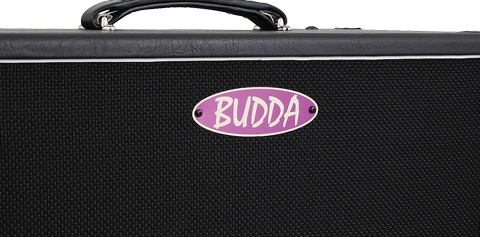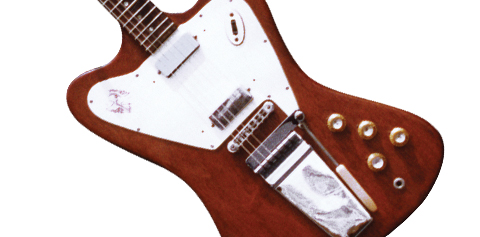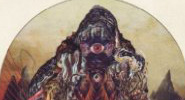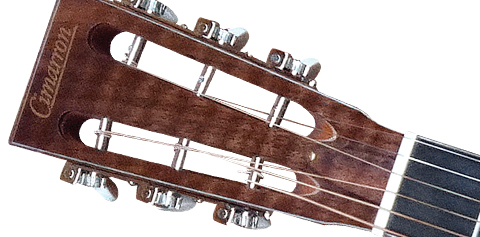 Siegmund’s Micro Tube Spring Reverb is a transformerless stand-alone unit that uses a musically balanced circuit that enhances the reverb springs with natural response from its micro tubes. It connects to guitar amp inputs or effects loops, studio mixing consoles, and PAs. The input can be switched to accept guitar pickup signals or any kind of processed signals at line level. Its Mix control interacts with the Reverb control, while Damping regulates the range of decay. Its three-spring/medium decay reverb tank is standard, while vintage-style two-spring/long decay tank is optional. Learn more at http://siegmundguitars.com/.
Siegmund’s Micro Tube Spring Reverb is a transformerless stand-alone unit that uses a musically balanced circuit that enhances the reverb springs with natural response from its micro tubes. It connects to guitar amp inputs or effects loops, studio mixing consoles, and PAs. The input can be switched to accept guitar pickup signals or any kind of processed signals at line level. Its Mix control interacts with the Reverb control, while Damping regulates the range of decay. Its three-spring/medium decay reverb tank is standard, while vintage-style two-spring/long decay tank is optional. Learn more at http://siegmundguitars.com/.
Month: September 2013
-
Siegmund Introduces Micro Tube Spring Reverb
-

The Budda Twinmaster
In the early days of boutique-amp building, there were but a few contenders on the scene. One of the strongest amplifiers in those days was made by Budda. First released in 1995, the company’s Twinmaster presented 18 watts of raw tone that made it a no-brainer buy for many, and it soon found its way into clubs, arenas, and recording studios. In the years to follow, the market was flooded with boutique combos, still, early Buddas retain a cache. After leaving the market for awhile, it recently returned. Yet, as with all reissues, the primary question is, “How does it stack up to the original?”
The Twinmaster is refreshingly simple and easy to use. It has twin inputs, one for normal gain, and a second with an extra gain stage. Handily, the amp is wired so that the user can use an A/B switch to switch between the two sides, creating a pseudo channel-switching setup. Topside, there are controls for volume, treble, and bass, along with on/off and standby switches. On its underside are jacks for a passive effects loop, speaker output, slave output, and an impedance selector switch for 8- or 4-ohms. The slave out is identical to the speaker out, except it’s padded and EQ’d to be line-level friendly. This feature is good for recording direct with an amped tone or plugging into effects and a stereo power amp for a wet/dry/wet rig. Also underside are the tube complement – two 12AX7s in the preamp, two EL-84s, and a 5U4 rectifier. The speaker is a Budda Phat 12, while the black-vinyl-covered cab is made from pine. The
Twinmaster is also a gig-friendly 42 pounds, thanks to an aluminum chassis that, we should add, is handwired in the U.S.A. Visually, the Twinmaster is also a fine-looking amp, with clean, top-mounted controls, and only a tasteful “Budda” logo on the front of the speaker grill.
For our tests we used a Gibson ’59 Les Paul Historic reissue, and a Stratocaster. Plugging the Strat into the Twinmaster’s normal-gain input, we dialed in a robust clean tone. The amp’s midrange push gave our Strat a certain weightiness that gave its normally weak bridge pickup some added heft. To boot, even single notes from the Strat seemed to carry more authority. Turning the tone controls provided interesting tonal development, but always with its midrange thrust – a Twinmaster trademark.
Turning up the Volume knob makes the amp louder without adding much hair until it passes the halfway point. For more oomph, shifting to the high-gain input makes single-coils bark with the Volume control barely turned up. With its added gain stage, this input is a high-gain beast, even with the mild 6k-output pickups in our test Strat.
A Les Paul into the high-gain input takes you straight to Rock City, creating creamy, robust distorted tones that clean up nicely for chunky rhythm riffs (by dialing it down to about 7 on the guitar’s Volume knob). Switching back to the low-gain input cleans things up, but the Twinmaster could never be considered a clean machine when using a humbucker-equipped guitar like the ’59. The amp is very pedal-friendly, as well. While some amps’ input stages will cringe at boosts, and various gain pedals, the Budda’s handled them all.
How does the new Twinmaster compare to the original Budda? Quite well, actually. Kudos to the company for not reinventing the wheel and staying close to the original amp produced 16 years ago. Furthermore, it doesn’t try to sound like a Vox or a blackface Fender; it sounds like a Budda, and that’s a significant victory right there. The Twinmaster has always had its own sound, due to its fatness and pleasant midrange emphasis, and this speaks to both the circuit design and a well-chosen speaker. It’s a very solid amp, both in construction and tone, and excels as a grab-and-go amp for club gigs or rehearsals. If you’re in the market for a new combo with a tone that is “phat” and soulful, the Budda Twinmaster fits the bill.
Budda Twinmaster
Price: $1,999.
Contact: budda.com
This article originally appeared in VG September 2011 issue. All copyrights are by the author and Vintage Guitar magazine. Unauthorized replication or use is strictly prohibited.
-
SpiderCapo Offers Twist
 SpiderCapo’s six independent fingers make it possible for a player to employ multiple tunings within a song, and use open tunings and barre chords without de-tuning. It weighs one ounce, fits all standard electric guitars and nylon- or steel-string acoustics, and uses leather on surfaces where the capo is in contact with the guitar’s neck. See more at www.spidercapo.com.
SpiderCapo’s six independent fingers make it possible for a player to employ multiple tunings within a song, and use open tunings and barre chords without de-tuning. It weighs one ounce, fits all standard electric guitars and nylon- or steel-string acoustics, and uses leather on surfaces where the capo is in contact with the guitar’s neck. See more at www.spidercapo.com. -
Dominick Montuoro, Noted Danelectro Collector, Passes
Dominick Montuoro, a noted authority and collector of Danelectro guitars, passed away September 11 at his home in Florida. He was 72. Montuoro began collecting guitars in the late ’70s when a Silvetone amp-in-case caught his eye. From there, he began to collect primarily Danelectro-made instruments, becoming one of the top early experts on the brand. Montuoro and his beloved Danos were featured prominently in two books written by fellow aficionado Doug Tulloch. He was also the subject of features stories in the Wall Street Journal and several local newspapers. Dominick was also a founding member of the Danelectro Club with Jay Rosen, Rick King, and several other enthusiasts.
Montuoro was a self-taught finger-style guitarist, using only books and tapes to hone his skills. He became accomplished at several of his favorite Reverend Gary Davis and Chet Atkins songs. – Brian Conner
-

Doug Doppler

Doug Doppler recalls how, at age five, his first swimming lesson fell on the same day as his first guitar lesson. Beyond mere coincidence, there is no connection between the two. Nonetheless, these days, Doppler is “swimming” in guitars – specifically, vintage Ibanez.Doppler is an L.A.-based musician and great example of how a guitarist can make a living playing even if they don’t regularly perform on huge stages with superstars at their side. In the ’90s, he released an instrumental album called Ground Zero on Steve Vai’s Favored Nations label, and more recently recorded parts for the Guitar Hero video-game series. He also produces audio and video demos for manufacturers including Dunlop, Orange Amplifiers, Line 6, and Tech 21. He is also a former student of Joe Satriani, which might explain why Doppler is one very hardcore Ibanez guy.
“When I released Ground Zero, I reached out to Rob Nishida, who was the head of artist relations at Ibanez for many years,” he said. “He sent me a 540S, and soon after, I started putting together an arsenal of S-series instruments.”
The guitar offered enough intrigue that Doppler dug a bit deeper into the company’s lineage. His first vintage Ibanez was a model 2351 straight from the “lawsuit era” of the ’70s. “I bought it in 2003,” Doppler recalled. “From there, it was a slippery slope!”
Doppler has indeed taken the slide, amassing one of the baddest Ibanez collections around, complete with the highlight pieces lusted after by all Ibanezheads, including the much-ballyhooed “korina trio.”
We recently spoke with Doppler about the fine points of collecting what are arguably the preeminent Japanese-made electric guitars.
How did you teach yourself all you needed to know about Ibanez instruments before you started collecting them?
I’ve been a member of the ibanezcollectors.com forum for some time, and those guys really know their business. There’s a great culture there and people are happy to help if I have a question, which is not the case with all forums. Also, there’s a massive collection of vintage Ibanez catalogs available online, which I use to double-check model numbers, features, and hardware.
1) This ’74 2408-1 Artwood Dragon was one of three instruments Ibanez produced in very limited numbers and used in a 1974 catalog alongside the Black Eagle bass. Rumor has it approximately 30 instruments were sent to China to receive the carved tops. 2) This ’74 2408-2 Artwood Cornucopia was another member of the trio of instruments sent to China to receive the top carving. Doppler found it in South Africa. 3) The rarest instrument in his collection, Doppler won this doubleneck – which bears no model number or serial number – after what he calls a “…furious bidding war between myself and a French collector who has since become a dear friend.” After bidding crossed the $5,000 mark, Doppler bowed out. A few months later, the Frenchman found something he had to have and asked whether Doppler was interested in buying the guitar. Though someone added a second output jack and changed the knobs, the original vibrato bar and bridge cover are stowed in the case. “This model was featured in a photo, but not actually offered in one of the 1976 Ibanez catalogs, making it the most rare vintage Ibanez I know of,” said Doppler. 4) For the diehard collector, this 2662 hints at what was to become the Artist series. 5) This model 2364 was the Ibanez take on Dan Armstrong’s Lucite guitar. Another very rare example, Doppler found it in Austria.
What drew you specifically to the Ibanez lawsuit-era instruments?
The company produced a remarkably wide offering of designs, some that easily rival their Fender or Gibson counterparts. And they’re collectible because of their uniqueness; they have always been undervalued, I think. Unlike other copycat brands, Ibanez is relevant, which means they’ll become more collectible and significant. From a player’s perspective, a number of them are personal favorites.When you started collecting, were you looking for anything specific, or maybe a handful of potential models to buy?
Pretty much from the beginning, my goal was and is to own every lawsuit-era instrument they made. As much as I love the early Artists, the guitars I’m passionate about collecting are those, shall we say, “borrowed” designs.
6) When Doppler got this pre-serial-number 2352 Custom, it was all-stock but missing its bridge cover. He swapped the pickups for DiMarzios. 7) The big headstock and three-tone sunburst on this ’77 Silver Series 2375 exude the era’s vibe. The stock pickups were swapped for a set of Fender SCNs and Doppler used this instrument on a video to demonstrate Orange Amps’ Rockerverb. 8) Though it has a two-tone sunburst and a bullet truss rod – which isn’t right – this ’78 Silver Series 2375 remains one of Doppler’s favorite players. He used on a number of Guitar Hero sessions, including the remake of Iron Maiden’s “Wrathchild.” 9) Though this ’78 Silver Series 2375 is a refin, “I had to have it,” said Doppler. The pickups have been changed. 10) Hoshino used several brand names in its distribution territories. Doppler found this all-stock ’75 Mann 2348 in Canada and has used it extensively on Get Killer Tone.
Do you have any personal rules or guidelines you follow when you find a guitar you’d like to add to the collection?
I’m careful to always follow my Rule of Ten, which reflects the fact that although these instruments may be valued at one tenth of their inspirational counterparts, I believe the value drops more, percentage-wise, if they do not have all the original parts. There are a lot more instruments on the market these days, but many of them are the most common ones or are not original. Buying now is about being smart and making each purchase count.Why are pre-serial-number guitars more desirable?
Generally speaking, they were made at the very beginning of a model run, and possibly got a bit more attention in manufacture compared to those that followed. It’s generally thought that there were fewer of these instruments than when a production run got up and running, but given the number of pre-serial-number instruments I own, that logic may not be the case for all models.
11) Doppler found this ’75 model 2351M in Canada. Note the mismatched Standard fingerboard inlays with the Custom headstock inlay and truss-cover badge. 12) Unlike the ’75 2351M, this ’77 version has the matched Standard neck inlays and truss cover, along with original tuners. 13) “As a true testament to how crazy the collecting thing can get, I decided to pick up this lefty,” Doppler said of this ’77 2350L. “I later discovered the middle pickup was not original, but it’s still a cool piece, and it’s in great shape.” 14) The stock pickups in this 2351 were exceedingly microphonic, which forced Doppler to swap them for a set of DiMarzios. 15) This all-stock model 2343 is one of Doppler’s favorites.
Anyone who collects more-traditional brands knows that when you delve into old guitars, you have to be on the lookout for things that affect originality – changed parts, refinishes, etc. Given that Ibanez instruments came of age at a time when modding guitars was commonplace, do collectors have to be all the more wary?
Surprisingly, few of the guitars I’ve seen come to market have major modifications, which, considering the era, is pretty remarkable.What are the most commonly replaced parts, and why were they swapped?
In the ’80s, a lot of people thought different pickups and tuning gears were an improvement. Most of the time, I’ll swap pickups because the originals have gone microphonic and I’d have to take them out, anyway. Since these instruments are not as valuable as Gibsons or Fenders, I’m not as concerned about the wiring harness remaining untouched.
16) This pre-serial number 2377 is all-stock and Doppler has used it on a number of Orange Amps videos. 17) This ’77 model 2387 has its original tuners and pickups. 18) Doppler found this ’78 2355 on Craigslist. “I showed up to find a nearly original instrument with a small neck crack the seller did not mention in advance,” he said. “So I got it at a great price, and I’ve used it a ton.” 19) This pre-serial-number 2402 has original tuners and pickups. 20) Doppler calls this ’76 2404, “A neat, all-stock piece.”
You’ve scored most of your guitars via internet auction. What do you advise people about that process?
The “freshman” collector buys first, then learns what they did wrong second. There are enough of these instruments on the market that if you miss one, you’ll most likely find another. I almost never bid on an instrument when the seller has less than 99 percent positive feedback or has less than 25 transactions. I also don’t trust people who charge too much for shipping, and I’ll pass on a guitar where the seller thinks they’re going to make an extra buck for packing it and dropping it off at FedEx or UPS. It reeks of “freshman,” and those are deals to watch out for.When you talk to someone about getting into collecting Ibanez guitars, what advice do you offer?
First, I tell them that they need to know the market before pulling out their wallet. It’s easy to think you’ve made a huge local score on some website only to find out you’ve been had. A smart collector knows what they’re looking for before it comes up, and they know how much they’re willing to pay.
21) The cutout on the headstock of the 2409B Black Eagle bass is typically broken because the piece on the treble side was left quite thin after the rout. This one is from ’75. 22) An all-stock ’76 2387B-CT. 23) This pre-serial number 2366FLB is one of two Doppler has ever seen offered for sale. It’s all-original. 24) Doppler says this awkward-looking 2030 has wonderful tone. “It’s completely stock, in great condition, and the only one of its kind I’ve seen,” he said. 25) One of Doppler’s first vintage Ibanez basses was this 2366B. “The stock pickup was dead, so it has been replaced,” he said. 26) This pre-serial-number 2357DX is one of Doppler’s crown jewels. “I scoured the globe and tracked it down in Germany,” he said. “It sounds and plays like a Höfner and is ultra-rare in this condition.”
How did your connection develop with Satriani and Vai?
When I was in high school, I studied with Satch for 31/2 years. When I got ready to head to GIT, he gave me Steve’s phone number. Flash forward a couple decades, and Joe kindly sent Steve my newly mixed Nu Instrumental disc, which he released on his Favored Nations label.
27) “This poor instrument has been through hell and back,” Doppler said of this 2387B. “I stripped most of the matte-black paint to reveal the original finish, and it came with all-original components.” 28) This all-stock 2369B has the pickup combination with three-way toggle. 29) The cracks in the finish and bits of missing binding are testimony that this pre-serial-number model 698MS has been well-played. “There is little information on the acoustics from this era, but I’m fairly certain the pickup is stock, and it still works like a charm,” Doppler said. 30 and 31) “Though I don’t really play mandolin, I thought these would make a great addition to the collection,” Doppler said of this model 511 and 513, both pre-serial-number.
So where might we have heard you use some of these instruments?
I used two of the Silver Series 2375 models on the Guitar Hero sessions; the two-tone sunburst on the classical intro to Extreme’s “Play With Me” and one of the rhythm parts on Iron Maiden’s “Wrathchild” and the three-tone sunburst on the solo for White Lion’s version of “Radar Love.” I also do a ton of video work for Orange, and I love to get them in the mix. I’m always happy to see the positive comments about them on YouTube.What projects do you have in the works where you’re using your Ibanezes?
In June, I’ll be releasing a DVD where I demo 100 modern and vintage time-based effects. It’s called Get Killer Tone: Delay/Looper/Reverb. And there’s more in the works. “Korina” Trio
“Korina” Trio
Though their bodies weren’t actually made with Korina – they’re probably a Japanese wood called sen – Doug Doppler says the Ibanez guitars made to look like Gibson’s famed korina instruments are highly desirable because their finish work was outstanding, “And they play as good as they look!” he said. “The Rocket Roll Sr., Destroyer, and Futura are probably the most collectable because they do a brilliant job of paying homage to what were some of the finest instruments Gibson ever – and never – made.”
This article originally appeared in VG June 2012 issue. All copyrights are by the author and Vintage Guitar magazine. Unauthorized replication or use is strictly prohibited.
-

Gibson’s “Non-Reverse” ’Birds
In the ’60s, Gibson strived mightily to meet the demands of players of all levels while also working to maintain its image as industry leader. One of its primary attempts at the latter involved the Firebird guitars and Thunderbird basses introduced in ’63. Marked by innovative neck-through construction, unique features and looks, the Thunderbird’s full-size scale (a first for a Gibson bass), and a coinciding push of Gibson’s new custom-color finishes, one would think the story of the ’Birds would include the phrase “gloriously successful.” But one would be wrong! The truth is, as with so many models, neither instrument was a runaway success.

Firebird I (reverse) One mini-humbucking pickup, wrap-around bridge, unbound rosewood fretboard, dot fret markers. 
Firebird I (non-reverse) Two black P-90 pickups, vibrato, unbound rosewood fretboard, dot fret markers. 
Firebird III (reverse) Two mini-humbucking pickups, vibrato, unbound rosewood fretboard, dot fret markers. 
Firebird III (non-reverse) Three black P-90 pickups, vibrato, unbound rosewood fretboard, dot markers. Maybe they were too unique or too fancy for the era, but for whatever reason, midway into 1965 – the models’ third year – Gibson implemented dramatic revisions; gone was the funky “reverse” body shape, replaced with a more-conventional silhouette. The headstock of the Firebird acquired standard tuners in place of its rear-projecting/banjo-style machines, and its pickups, pickup layout, and pickup selector were changed from a standard toggle to a slider switch. Both models were given more-traditional glued-in necks and unbound fingerboards, and dot markers. The Firebird was given a side-pull vibrato tailpiece, validating the notion Gibson was pursuing cost-savings in its manufacture.

Firebird V (reverse) Two mini-humbucking pickups, deluxe vibrato, bound rosewood fretboard, trapezoid-shaped fret inlay. 
Firebird V (non-reverse) Two mini-humbucking pickups, deluxe vibrato, unbound rosewood fretboard, dot fret markers. The Thunderbird’s electronics, hardware, and layout were left unchanged in the transition. The single-pickup Thunderbird II kept its Volume and Tone controls, while the two-pickup Thunderbird IV still had two Volume controls and a master Tone (with no toggle). Control layout changed slightly from three evenly spaced knobs to a slight space between the two Volume knobs and the Tone on the non-reverse variant.
For all of their ho-hum aesthetics compared to the original, the ergonomics of non-reverse versions make both guitar and bass more balanced and comfortable, because the weight of the larger body quadrant housing the controls tends to place the neck in a more-upright position when strapped on.
Firebird V (reverse) Two mini-humbucking pickups, deluxe vibrato, bound rosewood fretboard, trapezoid-shaped fret inlay. 
Firebird VII (non-reverse) Three mini-humbucking pickups, deluxe vibrato, unbound rosewood fretboard, dot inlay, gold hardware. The non-reverse versions have always had their fans. In the ’70s heyday of Roxy Music, guitarist Phil Manzanera gigged with reverse and modified non-reverse Firebirds fitted with full-size humbucking pickups. More recently, Warren Haynes has used newer non-reverse Firebirds onstage with Gov’t Mule. Lynyrd Skynyrd bassist Leon Wilkeson (1952-2001) often staged a non-reverse Thunderbird.
Noted guitar authority and author Tom Wheeler once compared the original Firebirds and Thunderbirds to Errol Flynn in terms of their aesthetic appeal, while pronouncing the non-reverse versions the fretted-instrument equivalent of Elmer Fudd. Most collectors agree with (and laugh at!) the assessment. But for some, the non-reverse versions are nonetheless a comfortable, easy-to-play collectible.
This article originally appeared in VG October 2011 issue. All copyrights are by the author and Vintage Guitar magazine. Unauthorized replication or use is strictly prohibited.
-

Red Fang
 Throughout 10 pummeling tracks, the Portland, Oregon-based Red Fang demonstrates everything that is right with heavy metal today, displaying an excellent array of influences, from Black Sabbath to Alice In Chains to Metallica. The resulting metal can be safely filed under the sub-genre of “stoner metal,” alluding to the sound Sabbath made famous 40 years ago. The sound regained popularity in the ’90s, thanks to various grungers, and remains hip today. And certainly, Red Fang has a real knack for this slow and heavy style of metal.
Throughout 10 pummeling tracks, the Portland, Oregon-based Red Fang demonstrates everything that is right with heavy metal today, displaying an excellent array of influences, from Black Sabbath to Alice In Chains to Metallica. The resulting metal can be safely filed under the sub-genre of “stoner metal,” alluding to the sound Sabbath made famous 40 years ago. The sound regained popularity in the ’90s, thanks to various grungers, and remains hip today. And certainly, Red Fang has a real knack for this slow and heavy style of metal.Don’t look for glossed-up production or tricky arrangements anywhere on this CD. The accent is on strippeddown, lo-fi riffing, such as on “Wires,” a track with crushing, drop-tuning chords and moody guitar harmonies. Its closing guitar solo is perfectly abrasive, with no concessions to technique or audio fidelity; the goal is simply to reach through the speakers and punch the listener in the face. “Hank Is Dead” sounds like a lost Alice In Chains track but also captures the bottom-heavy Fang sound quite effectively. Unlike, say, Metallica – a band whose guitars are typically trebly and shrill – axemen Maurice Bryan Giles and David Sullivan prefer a muted, deep, crunch tone, as if they rolled back the tone knobs on their solidbodies. “Dirt Wizard” is another good example, using a dramatic, ascending figure at the chorus and perfectly stoner-ish riffs throughout. And “Throw Up” plays up a chugging, bass-laden groove with sick, backward-guitar licks on top. It’s epic stuff, and either you love or you don’t.
Bottom line: If Murder The Mountains is an indicator of the direction that metal is going these days, then count me in. Red Fang is the real deal.
This article originally appeared in VG‘s June ’12 issue. All copyrights are by the author and Vintage Guitar magazine. Unauthorized replication or use is strictly prohibited.
-
Brooklyn Guitar Show
Doug Myer of Mountain Cat Guitars with a pelham blue SG Joe Menza of Best Guitars with a Gretsch Silver Jet Baker Rorick with Steve Uhrik and Peter of Retrofret Vintage Baker, Lisa, John Peden, Peter at Peden Vintage Lorenza Cocco Golden and Richard Cocco show off the new Rx Series Electric Bass strings Evert Wilbrink of Teye Guitars and Doug Myer of Mountain Cat Guitars Peter Dudley of Dudley Custom Guitars Bill Imperial of Imperial Guitars -

Cimarron Guitars’ Model P
Cimarron Guitars has being making custom instruments since 1978 in the dry, mild climate of southwest Colorado.
The company’s Model P guitar gets its name from its parlor-guitar-sized body (“parlor” guitars were popular in the late 19th/early 20th century, when small social events often occurred in parlors where music was played; the instruments typically were small, inexpensive pieces). It has rosewood back and sides with a solid Sitka spruce top, a three-piece, dovetailed, set maple neck with a double-action, adjustable truss rod. Two graphite rods ensure stability, and the neck is topped with an ebony fingerboard. Other details include a slotted headstock, adorned with Gotoh tuners that give the guitar a classic look. The bridge is ebony, which gives a nice aesthetic matched to the ebony fingerboard. Its look is finished with a tortoise pickguard and classic binding and a nitrocellulose lacquer finish.
The Model P is quite small, even for a parlor guitar. Its upper bout measures 8.25″ inches, while the lower bout is 12.25″. Thickness at the heel is 35/8″. But at first strum, it’s apparent this little guitar has big attitude. An open G chord impresses with its low-end response and volume. Granted, it’s no Super Jumbo, as it does relay a bit of that boxy small-body tone, but still, many preconceptions about size fade as one becomes engulfed by the sound of this little guitar.
The Model P exhibits excellent craftsmanship, works very well for playing styles ranging from fingerpicking to chordal passages, and tracks very nicely in the studio.
If you’re into parlor or other types of small-body acoustics, you’ll want to check out this instrument. Beyond its cool appearance, it’s a convenient size for travel, offers dreamy playability, and sounds wonderful.
Cimarron Model P
Price: Starts at $2,500 ($2,700 as tested)
Contact: cimarronguitars.com
This article originally appeared in VG October 2011 issue. All copyrights are by the author and Vintage Guitar magazine. Unauthorized replication or use is strictly prohibited.
-

Gustav Lundgren
 Gustav Lundgren is boldly going where few other Gypsy jazz guitarists dare: the daunting and little-known world of Django Reinhardt’s later bebop music.
Gustav Lundgren is boldly going where few other Gypsy jazz guitarists dare: the daunting and little-known world of Django Reinhardt’s later bebop music.Swede Lundgren is prolific in both the worlds of standard jazz guitar and Gypsy jazz, with seven previous releases to his name plus numerous others as a sideman. He has proved himself adept on both acoustic and electric in multiple formations from intimate trios to horn-powered big bands. But this new album stretches him in new ways.
Throughout, Lundgren has chosen mainly to cover Django’s electric bebop on acoustic guitar. In the late 1940s and up until his death in 1953, Django rejoiced in the volume, sustain, and yes, even the overdrive of his electrified Selmer in recasting his early swing into the sound and fury of bebop. Lundgren’s acoustic fretwork puts the emphasis on a different sort of technique in relying on purely melodic improvisation. He’s backed by a pounding acoustic rhythm section, whereas Django had updated his sound to rhythmic chordal stabs in the best 52nd Street tradition. It’s an ambitious venture, and the result is inspiring.
He kicks off with “Impromptu,” Django’s ferocious reworking of both a Dizzy Gillespie bop tune intermixed with the waltz “Dark Eyes.” Lundgren’s fretwork is fast but sure at a tempo that would tie most players’ fingers into knots. His version of Django’s worldweary ballad “Anouman” on acoustic guitar is gorgeous – and challenging, at 7:25. Django’s version was played mostly by his saxophonist, so hearing the songs translated fully to guitar is enlightening. Lundgren’s playing of both the theme and his extended solo is endlessly creative, accented by stirring arpeggiated runs as well as bass-to-treble and volume dynamics.
This article originally appeared in VG‘s June ’12 issue. All copyrights are by the author and Vintage Guitar magazine. Unauthorized replication or use is strictly prohibited.











